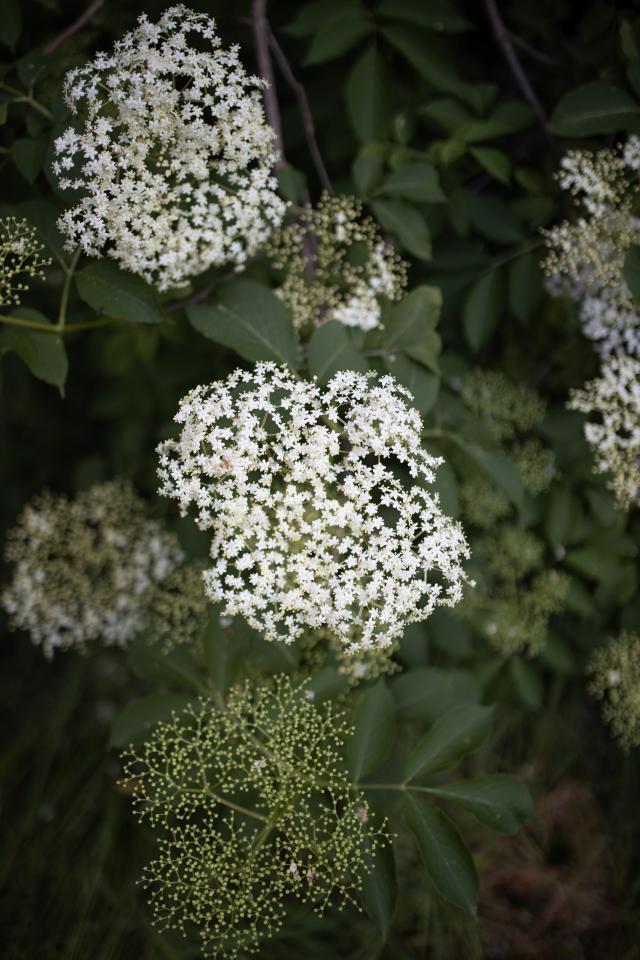In stories like “Gone with the Wind” about life in the south of the USA we often hear about “elderberry”, but apart from knowing it was made into wine I had no idea what it was, what it looked like or how it was used.
I applaud some of our local businesses that endeavour to have their premises decorative and Integria in the industrial estate is one of my favourites with the botanical paintings on the buildings. In the front of this building I believe I have found an elderberry shrub that has been in bloom for months and now has bunches of purple/black berries all over it. The creamy white clusters of blossoms have been most attractive for a long time.
On research I found that while it is native to Europe, it has become naturalised in America.
I also found we have an Australian native elderberry that grows along the edges of the rainforests of North Queensland right down to the east coast of Tasmania.
The European variety is not too large to be included in a reasonably sized home garden and would be an extremely decorative addition.
It is a shallow-rooted shrub, so will need watering regularly until established. Full sun is required to get the best from flowers and berries. However, if you are growing it primarily for its decorative foliage, it will tolerate partial shade. They spread by root sprouts, sending up many canes, that should be kept pruned out or they can become a problem or invasive along waterways.
They will grow from 6 to 12 feet high and about 6 to 8 feet wide, so do need some room. They will achieve this size within a few years and can fruit in the first season. They can be grown very effectively as a hedge and would look amazing covered in the decorative clusters of white flowers. The unripe fruit is toxic to both humans and animals as they contain small amounts of cyanide!! There goes any hope of me planting one!
My yard does not have a front fence and so I would not be able to restrict access to the shrub and would not be prepared to take the risk of poisoning someone’s favourite pet! In fact, it appears that the only part of the bush that isn’t toxic is the ripe berries, and even they should not be eaten raw. Maybe not something for inclusion in a pet-friendly garden after all.
Albeit when they are ripe, the berries are reputed to have 3 times the antioxidants of blueberries and cranberries, all sorts of vitamins and minerals and have long been used as a treatment for coughs and colds. There is some evidence that they may be effective against some viruses..research is continuing into this.
Now I’ll go back to some details of our native elderberry as it appears to be much more suited to inclusion in a garden.
The botanical name for the native variety is Sambucus Australasica, while the other one is Sambucus nigra, and the fruit, flowers and leaves appear to be able to be used in similar ways but without the nasty toxins.
The flowers seem to be less profuse and not as spectacular as the exotic ones, but the fruit looks wonderful in the photos I have seen. The yellow, as opposed to purple/black, berries can be eaten raw and are very attractive to birds and so would make a great addition to a garden. It will not become invasive like its cousin and the fruit can be used to make jam, wine and cordials if that is what is needed. All in all it seems to be a much better option than the exotic variety.
As I am writing this there is, once again, an amazingly heavy fog over town. I readily admit to being entranced by it and love the fact that it blocks out any noise and encapsulates me in a quiet, wonderful world, with no distractions! I don’t like driving in heavy fog but am fortunate that I don’t have to! From my high vantage point, I can gradually see the town appear as it lifts. First, usually, is the spire on St Mary’s floating high and then gradually, the rest of town appears…entrancing!!
Once again a reminder for the Garden Extravaganza during Jumpers and Jazz in July. Definitely a “must-see” for everything gardening and even maybe some ideas on how to use the produce from the vegetable patch.
Certainly worth a visit just for Shirley’s wonderful scones and a cuppa and the array of tasty soups and fresh bread available for a quick lunch.
Plan a visit on the 27th or 28th July for a catch up with friends in St Mary’s Hall in Wood Street.







